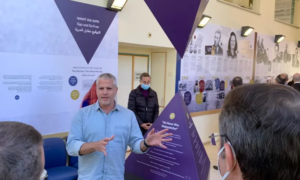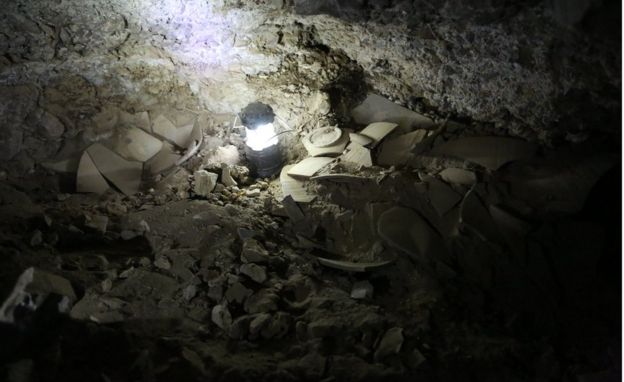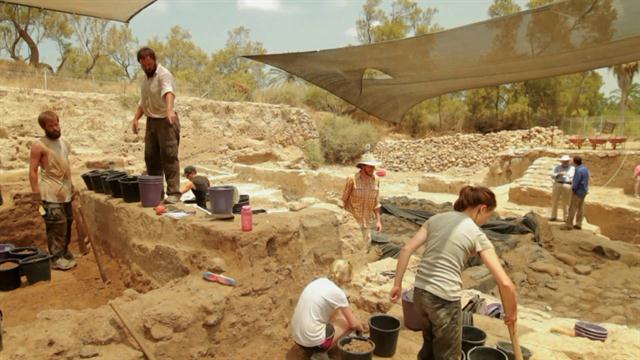
IT IS the seventh day of the Jewish month Nisan in the year 33 C.E. Imagine that you are observing events in the Roman province of Judea. Leaving Jericho and its lush foliage, Jesus Christ and his disciples are trudging up a dusty, twisting road. Many other travelers are also on their way up to Jerusalem for the annual Passover celebration. However, more than this tiring climb is on the minds of Christ’s disciples.
The Jews have been yearning for a Messiah who can bring relief from the Roman yoke. Many believe Jesus of Nazareth to be that long-awaited Savior. For three and a half years, he has been speaking about God’s Kingdom. He has cured the sick and fed the hungry. Yes, he has brought comfort to the people. But the religious leaders are chafing under Jesus’ burning denunciation of them and are desperate to have him killed. Yet, there he is, walking purposefully up the parched road in front of his disciples.—Mark 10:32.
As the sun dips behind the Mount of Olives up ahead, Jesus and his companions reach the village of Bethany, where they will spend the next six nights. There to welcome them are their beloved friends Lazarus, Mary, and Martha. The evening provides cool relief from the hot journey and marks the start of the Sabbath of Nisan 8.—John 12:1, 2.
Nisan 9
After the Sabbath, Jerusalem is abuzz with activity. Thousands of visitors have already converged on the city for the Passover. But the noisy commotion we hear is more than usual for this time of the year. Inquisitive crowds are rushing down narrow streets to the city’s gateways. As they shove their way out of the congested gates, what a sight greets them! Many jubilant people are making their way down the Mount of Olives on the road from Bethphage. (Luke 19:37) What is the meaning of all of this?
Look! Jesus of Nazareth comes riding on the colt of an ass. People spread garments out on the road ahead of him. Others wave freshly cut palm branches and joyfully shout: “Blessed is he that comes in Jehovah’s name, even the king of Israel!”—John 12:12-15.
As the crowd nears Jerusalem, Jesus looks at the city and is deeply moved. He begins weeping, and we hear him foretelling that this city will be destroyed. When Jesus arrives at the temple a short time later, he teaches the crowds and cures blind and lame people who come to him.—Matthew 21:14; Luke 19:41-44, 47.
This does not go unnoticed by the chief priests and the scribes. How vexed they are to see the marvelous things Jesus does and the jubilation of the crowds! Unable to conceal their indignation, the Pharisees demand: “Teacher, rebuke your disciples.” “I tell you,” Jesus replies, “If these remained silent, the stones would cry out.” Before departing, Jesus notes the commercial activities in the temple.—Luke 19:39, 40; Matthew 21:15, 16; Mark 11:11.
Nisan 10
Jesus arrives at the temple early. Yesterday, he could not help but be incensed at the gross commercialization of the worship of his Father, Jehovah God. With great fervor, therefore, he begins throwing out those buying and selling in the temple. Then he overturns the tables of the greedy money changers and the benches of those selling doves. “It is written,” Jesus exclaims, “‘My house will be called a house of prayer,’ but you are making it a cave of robbers.”—Matthew 21:12, 13.
The chief priests, the scribes, and the principal men cannot stand Jesus’ actions and public teaching. How they ache to kill him! But they are stymied by the crowd because the people are astounded by Jesus’ teaching and they keep “hanging onto him to hear him.” (Luke 19:47, 48) As evening approaches, Jesus and his companions enjoy the pleasant walk back to Bethany for a good night’s rest.
Nisan 11
It is early in the morning, and Jesus and his disciples are already on their way over the Mount of Olives to Jerusalem. As they arrive at the temple, the chief priests and the older men are quick to confront Jesus. Fresh on their minds is his action against the money changers and the traders in the temple. His enemies venomously demand: “By what authority do you do these things? And who gave you this authority?” “I, also, will ask you one thing,” Jesus counters. “If you tell it to me, I also will tell you by what authority I do these things: The baptism by John, from what source was it? From heaven or from men?” Huddling together, the opponents reason: “If we say, ‘From heaven,’ he will say to us, ‘Why, then, did you not believe him?’ If, though, we say, ‘From men,’ we have the crowd to fear, for they all hold John as a prophet.” Stumped, they weakly answer: “We do not know.” Jesus calmly responds: “Neither am I telling you by what authority I do these things.”—Matthew 21:23-27.
Jesus’ enemies now try to trap him into saying something for which they can have him arrested. “Is it lawful,” they ask, “to pay head tax to Caesar or not?” “Show me the head tax coin,” Jesus retorts. He asks: “Whose image and inscription is this?” “Caesar’s,” they say. Confounding them, Jesus states clearly for all to hear: “Pay back, therefore, Caesar’s things to Caesar, but God’s things to God.”—Matthew 22:15-22.
Having silenced his enemies with irrefutable argumentation, Jesus now goes on the offensive before the crowds and his disciples. Listen as he fearlessly denounces the scribes and the Pharisees. “Do not do according to their deeds,” he says, “for they say but do not perform.” Boldly, he pronounces a series of woes on them, identifying them as blind guides and hypocrites. “Serpents, offspring of vipers,” Jesus says, “how are you to flee from the judgment of Gehenna?”—Matthew 23:1-33.
These scathing denunciations do not mean that Jesus is blind to the good points of others. Later, he sees people drop money into the temple treasury chests. How touching to observe a needy widow drop in her entire means of living—two small coins worth very little! With warm appreciation, Jesus points out that, in effect, she has dropped in far more than all who made lavish contributions “out of their surplus.” In his tender compassion, Jesus deeply appreciates whatever a person is able to do.—Luke 21:1-4.
Jesus is now leaving the temple for the last time. Some of his disciples remark on its magnificence, that it is “adorned with fine stones and dedicated things.” To their surprise, Jesus replies: “The days will come in which not a stone upon a stone will be left here and not be thrown down.” (Luke 21:5, 6) As the apostles follow Jesus out of the congested city, they wonder what he could possibly mean.
Well, a little later Jesus and his apostles sit and enjoy the peace and quiet of the Mount of Olives. As they take in the splendid view of Jerusalem and the temple, Peter, James, John, and Andrew seek clarification of Jesus’ startling prediction. “Tell us,” they say, “When will these things be, and what will be the sign of your presence and of the conclusion of the system of things?”—Matthew 24:3; Mark 13:3, 4.
In reply the Master Teacher gives a truly remarkable prophecy. He predicts severe wars, earthquakes, food shortages, and pestilences. Jesus also foretells that the good news of the Kingdom will be preached throughout the earth. “Then,” he warns, “there will be great tribulation such as has not occurred since the world’s beginning until now, no, nor will occur again.”—Matthew 24:7, 14, 21; Luke 21:10, 11.
The four apostles listen attentively as Jesus discusses other aspects of ‘the sign of his presence.’ He emphasizes the need to “keep on the watch.” Why? “Because,” says he, “you do not know on what day your Lord is coming.”—Matthew 24:42; Mark 13:33, 35, 37.
This has been an unforgettable day for Jesus and his apostles. It is, in fact, the last day of Jesus’ public ministry before his arrest, trial, and execution. Since it is getting late, they start walking back the short distance over the hill to Bethany.
Nisan 12 and 13
Jesus spends Nisan 12 quietly with his disciples. He realizes that the religious leaders desperately want to kill him, and he does not want them to hinder his Passover celebration the following evening. (Mark 14:1, 2) The next day, Nisan 13, people are busy making final arrangements for the Passover. Early in the afternoon, Jesus sends Peter and John to prepare the Passover for them in an upper room in Jerusalem. (Mark 14:12-16; Luke 22:8) A little before sundown, Jesus and the other ten apostles meet them there for their last Passover celebration.
Nisan 14, After Sundown
Jerusalem is shrouded in the soft light of dusk as the full moon rises over the Mount of Olives. In a large furnished room, Jesus and the 12 are reclining at a prepared table. “I have greatly desired to eat this passover with you before I suffer,” he says. (Luke 22:14, 15) After a while the apostles are surprised to see Jesus get up and put his outer garments to one side. Taking a towel and a basin of water, he begins washing their feet. What an unforgettable lesson in humble service!—John 13:2-15.
However, Jesus knows that one of these men—Judas Iscariot—has already arranged to betray him to the religious leaders. Understandably, he becomes very distressed. “One of you will betray me,” he reveals. The apostles are highly grieved at this. (Matthew 26:21, 22) After celebrating the Passover, Jesus tells Judas: “What you are doing get done more quickly.”—John 13:27.
Once Judas has left, Jesus introduces a meal to commemorate his impending death. He takes a loaf of the unleavened bread, expresses thanks in prayer, breaks it, and instructs the 11 to partake. “This means my body,” he says, “which is to be given in your behalf. Keep doing this in remembrance of me.” He then takes a cup of red wine. After saying a blessing, he passes the cup to them, telling them to drink out of it. Jesus adds: “This means my ‘blood of the covenant,’ which is to be poured out in behalf of many for forgiveness of sins.”—Luke 22:19, 20; Matthew 26:26-28.
During that momentous evening, Jesus teaches his faithful apostles many valuable lessons, and among these the importance of brotherly love. (John 13:34, 35) He assures them that they will receive a “helper,” the holy spirit. It will bring back to their minds all the things he has told them. (John 14:26) Later in the evening, they must be very encouraged to hear Jesus say a fervent prayer in their behalf. (John, chapter 17) After singing songs of praise, they leave the upper room and follow Jesus out into the cool late-night air.
Crossing the Kidron Valley, Jesus and his apostles make their way to one of their favorite places, the garden of Gethsemane. (John 18:1, 2) While his apostles wait, Jesus goes a short distance away to pray. His emotional stress is more than words can describe as he earnestly petitions God for help. (Luke 22:44) The very thought of the reproach that would be heaped on his dear heavenly Father if he failed is agonizing to the extreme.
Jesus has barely finished praying when Judas Iscariot arrives with a crowd carrying swords, clubs, and torches. “Good day, Rabbi!” says Judas, kissing Jesus tenderly. This is the signal for the men to arrest Jesus. All of a sudden, Peter slashes out with his sword and cuts off an ear of the high priest’s slave. “Return your sword to its place,” says Jesus as he heals the man’s ear. “All those who take the sword will perish by the sword.”—Matthew 26:47-52.
Everything happens so fast! Jesus is arrested and bound. In fear and confusion, the apostles abandon their Master and flee. Jesus is led away to Annas, the former high priest. Then he is taken to Caiaphas, the present high priest, to be tried. In the early hours of the morning, the Sanhedrin falsely charges Jesus with blasphemy. Next, Caiaphas has him taken to Roman governor Pontius Pilate. He sends Jesus to Herod Antipas, the ruler of Galilee. Herod and his guards mock Jesus. Then he is sent back to Pilate. Jesus’ innocence is confirmed by Pilate. But the Jewish religious leaders pressure him to condemn Jesus to death. After considerable verbal and physical abuse, Jesus is taken out to Golgotha where he is mercilessly nailed to a torture stake and suffers an agonizing death.—Mark 14:50–15:39; Luke 23:4-25.
It would have been the greatest tragedy in history if Jesus’ death had brought a permanent end to his life. Happily, that was not the case. On Nisan 16, 33 C.E., his disciples were amazed to find that he had been raised from the dead. In time, more than 500 people were able to verify that Jesus was again alive. And 40 days after his resurrection, a group of faithful followers saw him ascend to heaven.—Acts 1:9-11; 1 Corinthians 15:3-8.
Jesus’ Life and You
How does this affect you—indeed, all of us? Well, Jesus’ ministry, death, and resurrection magnify Jehovah God and are crucial to the outworking of His grand purpose. (Colossians 1:18-20) They are of vital importance to us in that we can have our sins forgiven on the basis of Jesus’ sacrifice and can thus have a personal relationship with Jehovah God.—John 14:6; 1 John 2:1, 2.
Even mankind’s dead are affected. Jesus’ resurrection opens the way to bring them back to life in God’s promised Paradise earth. (Luke 23:39-43; 1 Corinthians 15:20-22) If you want to know more about such matters, we invite you to attend the Memorial of Christ’s death on April 11, 1998, at a Kingdom Hall of Jehovah’s Witnesses in your area.
“A Cave of Robbers”
JESUS had ample reason to say that greedy merchants had turned God’s temple into “a cave of robbers.” (Matthew 21:12, 13) To pay the temple tax, Jews and proselytes from other lands had to exchange their foreign money for acceptable currency. In his book The Life and Times of Jesus the Messiah, Alfred Edersheim explains that money changers used to set up their businesses in the provinces on Adar 15, a month before Passover. Beginning on Adar 25, they moved into the temple area in Jerusalem to capitalize on the tremendous influx of Jews and proselytes. Dealers ran a thriving business, charging a fee for every piece of money exchanged. Jesus’ reference to them as robbers suggests that their fees were so excessive that they were, in effect, extorting money from the poor.
Some could not bring their own sacrificial animals. Anyone who did so had to have the animal examined by an inspector at the temple—for a fee. Not wanting to risk having an animal rejected after bringing it a long distance, many bought a Levitically “approved” one from corrupt dealers at the temple. “Many a poor peasant was well fleeced there,” says one scholar.
There is evidence that onetime high priest Annas and his family had a vested interest in the temple merchants. Rabbinic writings speak of “the [temple] Bazaars of the sons of Annas.” Revenue from the money changers and from the sale of animals within the temple grounds was one of their main sources of income. One scholar says that Jesus’ action in evicting the merchants “was aimed not only at the prestige of the priests but at their pockets.” Be that as it may, his enemies surely wanted to do away with him!—Luke 19:45-48.
The Last Days of Jesus’ Human Life
Nisan 33 C.E. Events Greatest Man*
7 Friday Jesus and his disciples travel 101, par. 1
from Jericho to Jerusalem
(Nisan 7 corresponds to Sunday,
April 5, 1998, though Hebrew days
ran from one evening to the next)
8 Friday evening Jesus and his disciples arrive at 101,
Bethany; Sabbath starts pars. 2-4
Saturday Sabbath (Monday, April 6, 1998) 101, par. 4
9 Saturday evening Meal with Simon the leper; Mary 101,
anoints Jesus with nard; pars. 5-9
many come from Jerusalem to see
and hear Jesus
Sunday Triumphal entry into Jerusalem;
teaches in temple 102
10 Monday Early trip into Jerusalem; 103, 104
cleanses temple; Jehovah speaks
from heaven
11 Tuesday In Jerusalem, teaches at temple 105 to 112,
using illustrations; condemns par. 1
Pharisees; notes widow’s
contribution; gives sign of his
future presence
12 Wednesday Quiet day with disciples in 112,
Bethany; Judas arranges betrayal pars. 2-4
13 Thursday Peter and John prepare for 112,
Passover in Jerusalem; Jesus and par. 5 to
other ten apostles follow in late 113, par. 1
afternoon (Saturday, April 11,
1998)
14 Thursday evening Passover celebration; Jesus washes 113,
feet of apostles; Judas goes out par. 2
to betray Jesus; Christ institutes to 117
Memorial of his death (After
sundown, Saturday, April 11, 1998)
After midnight Betrayal and arrest in garden of 118 to 120
Gethsemane; apostles flee; trial
before chief priests and
Sanhedrin;Peter denies Jesus
Friday sunrise Before Sanhedrin again; to Pilate, 121 to
to sunset then Herod, then back to Pilate; 127,
sentenced to death; impaled; par. 7
buried
15 Saturday Sabbath; Pilate permits guards 127,
for Jesus’ grave pars. 8-10
16 Sunday Jesus resurrected 128
* Listed here are numbers identifying chapters in the book The Greatest Man Who Ever Lived. For a chart containing the detailed Scriptural references for Jesus’ final ministry, see “All Scripture Is Inspired of God and Beneficial,” page 290. These books are published by the Watchtower Bible and Tract Society of New York, Inc.



